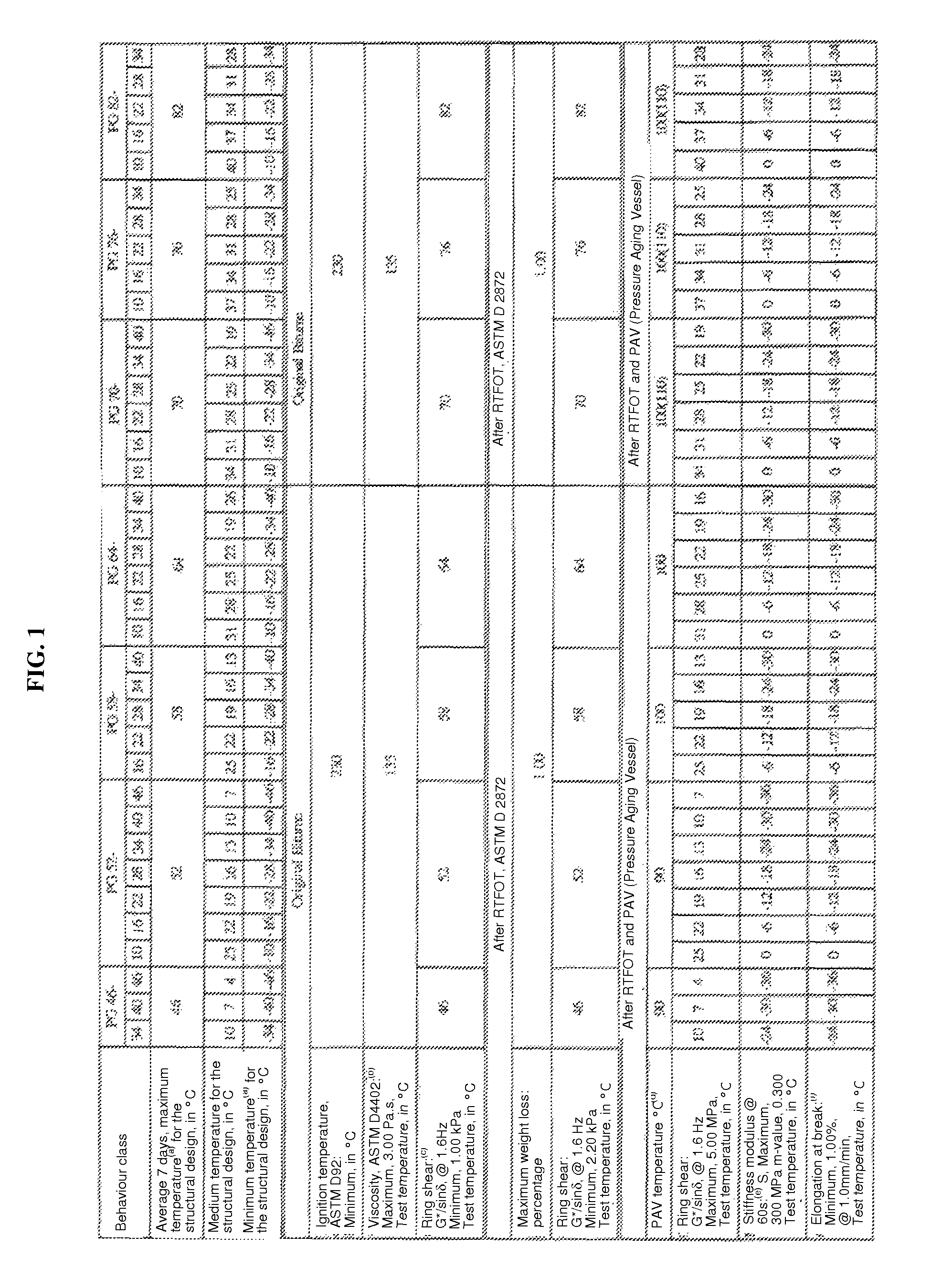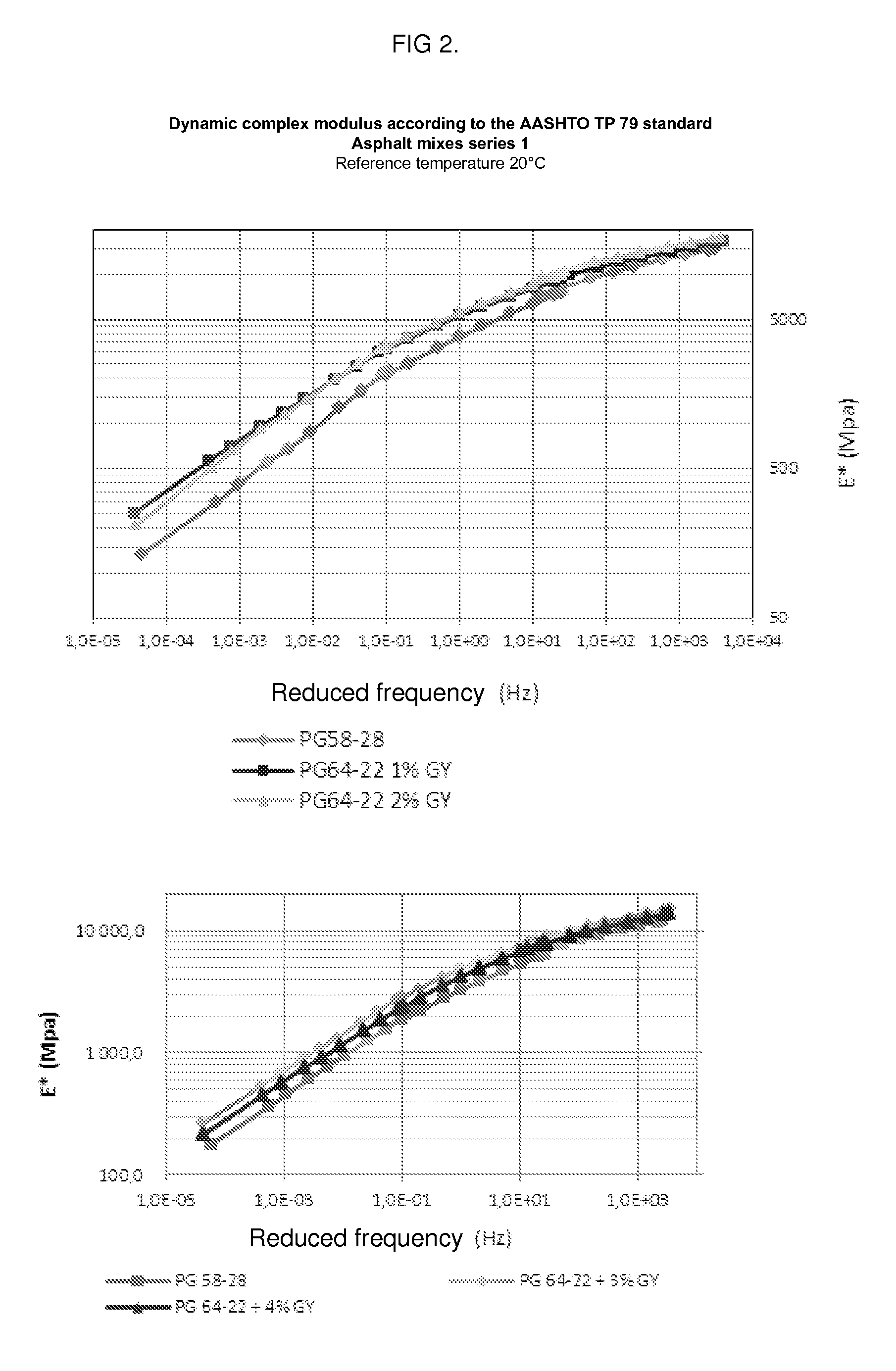Binder modified with glycerol for making asphalt mixes with a hicontent of recycled bituminous materials
a technology of binder and bitumen, which is applied in the field of asphalt mixes, can solve the problems of brittle fracture of the binder, cracks appearing in mortars, and rutting of the pavement, and achieve the effects of improving workability, compactability and performance, and simplifying the production method
- Summary
- Abstract
- Description
- Claims
- Application Information
AI Technical Summary
Benefits of technology
Problems solved by technology
Method used
Image
Examples
example 1
[0206]Asphalt mixes PG58-28 of series 1 and 2 are control asphalt mixes. Asphalt mixes PG64-22 1%, PG64-22 2%, PG64-22 3%, PG64-22 4% are asphalt mixes according to the invention. The binder with PG 58-28 is softer than the binder with PG 64-22. Series 1 and 2 were prepared from various batches of binders and recycled bituminous materials (reclaimed asphalt pavements and recycled asphalt shingles). The maximum nominal size of the control asphalt mixes and the asphalt mixes of the invention is 9.5 mm.
[0207]
series 1series 2Asphalt mixPG64-22PG64-22PG64-22PG64-22identificationPG58-281% GY2% GYPG58-283% GY4% GYGranular50% of a mixture consisting of 90%50% of a mixture consisting of 90%mixture*by weight of reclaimed asphaltby weight of reclaimed asphaltpavements (RAP) and 10% by weightpavements (RAP) and 10% by weightof recycled asphalt shingles (RAS)of recycled asphalt shingles (RAS)relative to the mixture weight 17%relative to the mixture weightof natural, crushed, non bituminous20% of...
example 2
[0209]A rutting resistance test for the asphalt mixes of Example 1 has been carried out according to the AASHTO T340-10 American standard called “Rutting susceptibility of hot mix asphalt using the asphalt pavement analyzer (APA)”. This test enables to simulate the rutting resistance of asphalt mixes by measuring the irreversible deformation at unique high temperature and at a unique frequency in the plastic deformation region.
[0210]The 6 types of asphalt mixes of Example 1 have been compacted so as to obtain a void fraction of 7±0.5%, they have been preheated at 64° C. and thereafter submitted to 8000 loading cycles. The load applied by three steel wheels was 445N, through hoses inflated with a air pressure of 70307 kg / m2.
[0211]
Series 1Series 2Asphalt mixControlPG64-22PG64-22ControlPG64-22PG64-22identificationPG58-281% GY2% GYPG58-283% GY4% GYRut depth (mm)6.40 ± 1.614.00 ± 0.655.20 ± 0.235.50 ± 1.765.30 ± 1.625.03 ± 0.98with 95%confidenceintervalsRut depth0.650.260.100.710.650..40...
example 3
[0216]The dynamic complex modulus E* of asphalt mixes of Example 1 was measured according to the AASHTO TP79 American standard called “Determining the dynamic modulus and flow number for hot mix asphalt using the asphalt mixture performance tester (AMPT)”. This test evaluates the dynamic deformation over all the temperature and frequency ranges in the linear viscoelastic region of small deformations. The deformation rate of this test which is ranging from 75 to 125 microdef was therefore lower than that of the rutting resistance APA test of Example 2 which was within the plastic region. The microdeformation (or microdef) corresponds to the ratio between deformation and initial size of the specimen expressed in ppm (10−6).
[0217]The AMPT principle consists in submitting 150 mm high×100 mm diameter cylinder-shaped specimens of asphalt mixes, also compacted to 7±0.5%, to a cyclic dynamic load in the linear viscoelastic region of small deformations so as to simulate the action of road tr...
PUM
| Property | Measurement | Unit |
|---|---|---|
| temperatures | aaaaa | aaaaa |
| temperatures | aaaaa | aaaaa |
| temperature | aaaaa | aaaaa |
Abstract
Description
Claims
Application Information
 Login to View More
Login to View More - R&D
- Intellectual Property
- Life Sciences
- Materials
- Tech Scout
- Unparalleled Data Quality
- Higher Quality Content
- 60% Fewer Hallucinations
Browse by: Latest US Patents, China's latest patents, Technical Efficacy Thesaurus, Application Domain, Technology Topic, Popular Technical Reports.
© 2025 PatSnap. All rights reserved.Legal|Privacy policy|Modern Slavery Act Transparency Statement|Sitemap|About US| Contact US: help@patsnap.com


